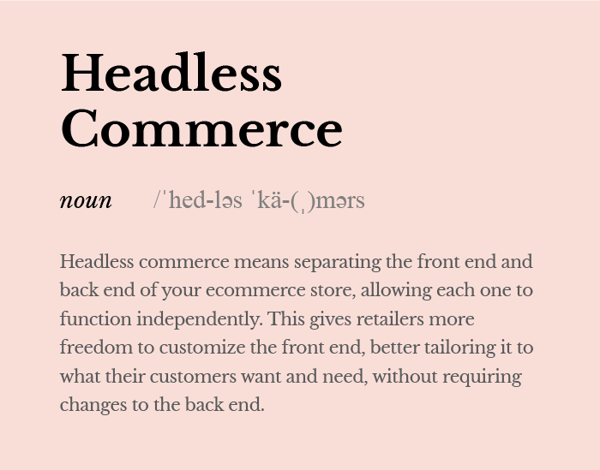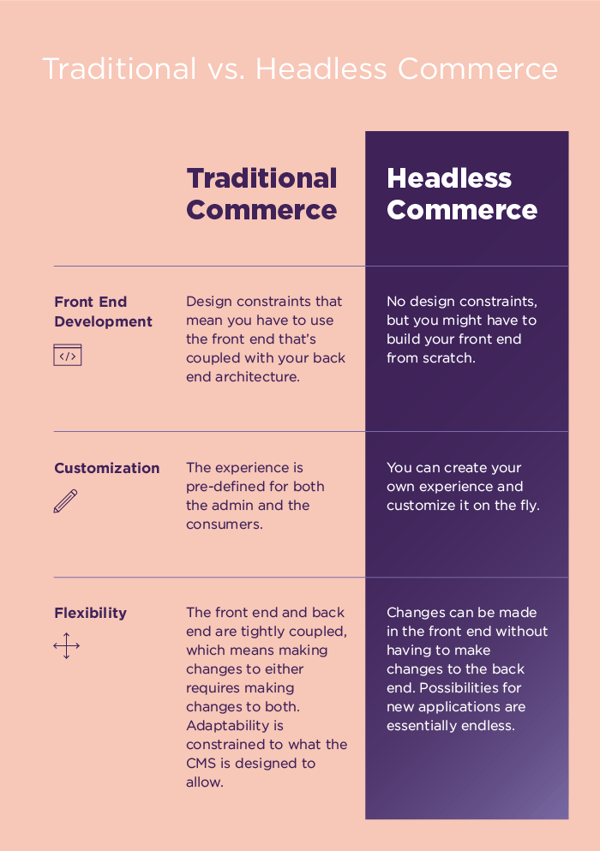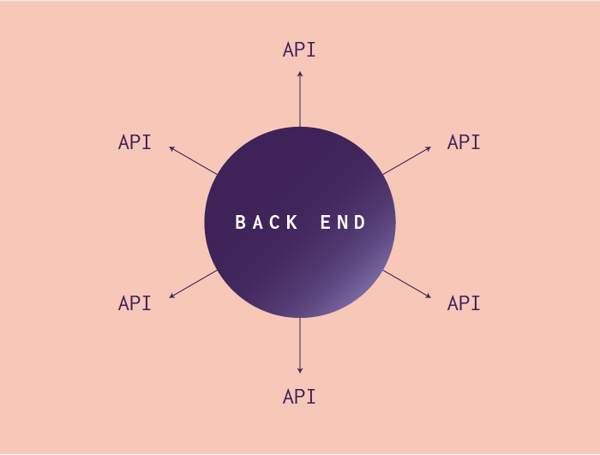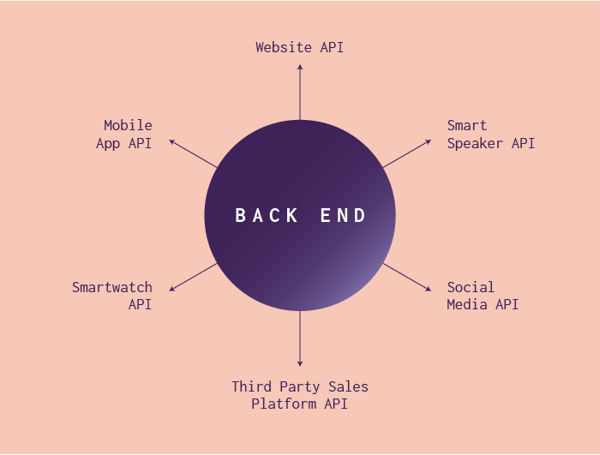April 6, 2020
 by Christina Marfice / April 6, 2020
by Christina Marfice / April 6, 2020

Many of today’s top e-commerce retailers are thinking, “Off with your head!”
No, they aren’t Alice in Wonderland’s Queen of Hearts on a villainous cartoon rampage. They’re talking about their commerce architecture, and the increasingly popular practice of adopting what’s called a headless commerce architecture.
Headless setups are a rising trend across industries, but they provide specific benefits that will appeal to online retailers in particular. If you’ve been considering a headless commerce architecture, but need a better understanding of the concept before you commit, you’ve come to the right place.
This guide will explain what headless commerce architecture is, how it works, its pros and cons, and different headless CMS platforms online businesses can use.
Ready to shout “Off with its head!” at your own architecture? Let’s get started.
First things first. What exactly is headless commerce architecture?
Simply put, headless commerce means having a back-end platform (commonly a CMS or content management system) that allows you to organize and manage all your product information, online content, marketing, and sales, but without an attached “front end,” or outward facing display layer.
When the front end is decoupled from the back end like this, businesses can manage all their back-end content and then use APIs to distribute it wherever it needs to go: their website, a mobile app, email marketing, e-commerce sales platforms, and even IoT devices.
A headless commerce setup with headless CMS personalization gives businesses more flexibility to publish content to as many channels as they want, and to make fast and easy customizations to their front end displays to tailor that layer to their customers’ changing wants and needs.

In other words, having a headless commerce architecture in place makes a retailer more agile and flexible. They can make changes to the customer experience quickly and easily, and that flexibility gives them more room to experiment with different customer journeys to see what’s the best fit for their buyers.
Headless commerce architecture is a natural choice for today’s online businesses because it allows them to meet the high expectation customers have for retailers in the digital age. It’s also one of the best ways for retailers to take advantage of the many new channels that are rapidly becoming available to them.
Instead of waiting for their CMS to support publishing content to IoT devices, a headless system allows them to use APIs to push content to those devices right away.
Headless commerce isn’t exactly new, so why is it that business owners and online retailers can’t stop talking about it right now?
It has to do with how technology is continuing to change people’s day-to-day lives. Particularly as more and more devices and household items become connected, and as we start experiencing even more digital touchpoints because of it, there’s a lot of opportunity for retailers to market and sell to customers via new channels.
The challenge is that they’re going to have to be fast and flexible to do it, because those new channels are arising all the time, and most traditional, coupled CMSes aren’t set up to take advantage of them.
So instead of waiting for CMS architecture to catch up to the new trends we’re seeing emerge from the IoT age, the solution is simple: Remove the head of your architecture. Then, use APIs to instantly jump on all those new channels. Get products to market in brand new channels quickly – faster than the competition, in fact. For online businesses, that means making more conversions and boosting profits.
Headless commerce also helps businesses with another trend: Customers’ rising expectations. As shoppers become more connected via wearables, smart devices, and other touchpoints, they expect their interactions with businesses to be seamless across all those different channels.
Businesses that are staying competitive in this digital age are the ones that are able to be truly omnichannel in the way they communicate with their customers, and thus meeting those high expectations for a flawless, seamless, and omnichannel customer experience.
More often, retailers are realizing that the way forward is headless commerce architecture. But for those that aren’t very tech-savvy, questions remain. One big one: How is this system different from what I already have?
How does headless commerce differ from traditional e-commerce? There are three main areas that are relevant to online retailers: front-end development, customization, flexibility.

Understanding how headless commerce architecture works is only half the battle, though. Businesses that are considering going headless need to also weigh the pros and cons.
For businesses considering going headless with their commerce architecture, the benefits are appealing. Here are just a few of the key benefits that come with employing a headless commerce system as an online retailer.
In the past, with traditional e-commerce architectures, retailers were bound by their CMS when it came to making changes to their sites. That meant involving IT or developers to make the necessary changes to the back end, something that took time and money and presented significant roadblocks to truly customizing the display layer of the site.
With headless commerce architecture, businesses can customize and personalize the front end of their site independently from the back end, making it easier to make quick changes to the customer experience as needed.
Since headless commerce architecture uses content APIs to push content to different platforms, businesses with headless setups have much more flexibility to roll out campaigns and new products more quickly than they could in the past.
They’re also able to take advantage of new marketing and sales channels almost instantly, and in today’s digital world, where there are more sales channels than ever before, that’s a major competitive advantage.
Because of the ease of customization and increased flexibility, retailers who use headless commerce systems can take advantage of another key benefit: faster time to market.
Rather than having to build out features in their CMS that allows them to push new products to new channels, retailers can use existing APIs and get their products online and ready for purchase immediately. And this solution is scalable. No matter how many new products a business launches, they can all get to market fast with a headless CMS system.
Because a headless commerce architecture is so flexible, retailers who use this kind of system have the agility needed to experiment with different channels and customer experiences. Their ability to constantly A/B test small changes means they can truly optimize conversions based on what they find works.
Online retailers already know how important it is for today’s top ecommerce businesses to embrace omnichannel marketing and selling. And headless commerce systems are one of the best ways to go omnichannel right now. From websites to mobile apps to sales platforms like Shopify, to Alexa skills and smart refrigerators and everything in between, there are more channels today than retailers have ever had before.
Traditional CMSes just aren’t set up to take advantage of all these channels, especially as new ones emerge all the time. Content APIs you can use with a headless system, though? Those can have you selling your products on as many devices as possible right away.
While the benefits of headless commerce definitely make the system worth looking into for online retailers, no architecture comes totally free from drawbacks. Here are the reasons businesses might want to think twice before diving headfirst into headless.
Headless commerce systems aren’t necessarily super simple. Depending on how you choose to create your display layer, you could end up relying heavily on front end developers whenever you need to make changes to your site.
Just because a business has decided it wants to go headless, doesn't mean it can implement a headless commerce architecture right away. Since the front end is no longer included as part of the CMS, that means you’ll have to find a template or build your own. That, of course, takes time.
This is more likely if you already use a CMS you love and want to build display layers to use with it. But if you’re starting your headless commerce architecture from scratch, you can speed up the process by working with a supplier of a headless solution that comes with pre-built (but tailorable) display layers.
Depending on how you set up your headless system, it can be expensive to implement. And in some cases, the costs can continue over time. Let’s say a retailer chooses to have a development team build a custom front end for their website. That will take a significant upfront investment to pay the experts who design the display layer. And then, if that retailer chooses to continue building bespoke front ends for different channels, costs are going to keep mounting over time.
Again, this can be avoided by investing in a headless solution with pre-built display layers and APIs. But doing that sacrifices some of the customization—one of the things that makes headless commerce so attractive to retailers in the first place.
For many retailers, though, the benefits far outweigh the drawbacks to going headless. And it’s definitely possible to mitigate (or even eliminate) some of the drawbacks by choosing a type of headless architecture that’s the best fit for your business’s needs.
These are some of the types of headless commerce architectures businesses might want to explore.
Pure headless commerce architecture means you have a back end…and that’s it. In this type of a platform, there’s no front end provided at all, and it’s entirely up to the retailer to choose or create a display layer they want to use.

A pure headless commerce architecture is a good choice for businesses that want maximum flexibility and can afford to invest in a team of front end developers to create front ends for their website and other channels they might use.
The downside to this kind of architecture is that it takes time and money to create the display layer for the system, which could slow time to market. Basically, this isn’t the right choice for your business if you want to get a headless commerce solution up and running in a hurry.
Alternatively, there are solutions that come from headless commerce architecture suppliers who offer pre-built APIs and display layers. These types of solutions can also come with front end templates, but they’re generally customizable to a point, so businesses can make them their own.

This kind of architecture is a good choice for businesses who don’t want anything slowing their time to market, or who want to expand to a lot of new marketing and sales quickly. They’ll be able to do so with a solution like this because of the pre-built APIs that are included.
A full-service solution isn’t for every business, though. Since the supplier has put in the time and financial investments to build the entire architecture, these solutions can sometimes come with hefty price tags. It’s important for businesses to shop around and find an architecture type and supplier that fits not only their e-commerce needs, but also their budget.
Connected devices and ubiquitous digital touchpoints aren’t the future – they’re now. This is the time that businesses – and especially online retailers – need to be thinking about how they’re going to access new sales channels as they arise, and how they’re going to do it quickly without sacrificing any aspect of their customer experience.
For many businesses, headless commerce is the way forward in our digital world. If you haven’t explored going headless yet, now is the time to see why this is the e-commerce solution business owners can’t stop talking about.
Explore the best headless CMS solutions for your e-commerce business needs now.
Christina Marfice is a freelance writer who covers ecommerce, technology, and customer experience. She works with Plytix, a headless product information management system designed for fast-growing product brands.
Look, I’m no web developer. I don’t mess with code or follow the latest JavaScript frameworks....
 by Soundarya Jayaraman
by Soundarya Jayaraman
A content management system (CMS) helps people manage and publish content digitally.
 by Sagar Joshi
by Sagar Joshi
From personalized customer experiences to efficient supply chain management, generative AI is...
 by Carl Bleich
by Carl Bleich
Look, I’m no web developer. I don’t mess with code or follow the latest JavaScript frameworks....
 by Soundarya Jayaraman
by Soundarya Jayaraman
A content management system (CMS) helps people manage and publish content digitally.
 by Sagar Joshi
by Sagar Joshi

